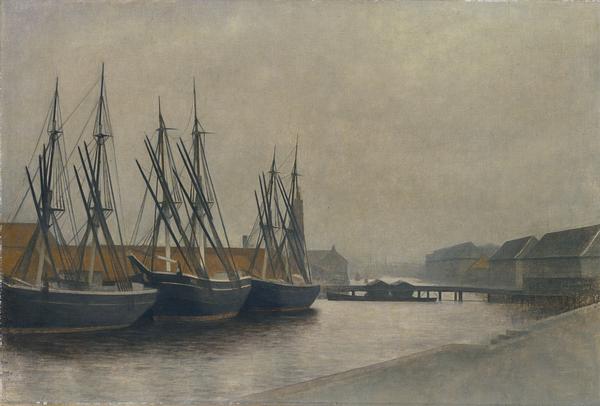In 1898, Vilhelm Hammershøi moved to Christianshavn – a district in Copenhagen distinctive for its maritime and industrial environment. The neighbourhood became very important to him, both personally and artistically: Hammershøi had found an apartment in Mikkel Vibes Gård at Strandgade 30, which would form the setting of his life until 1908. Here he painted some of the interior scenes for which he would later become so famous (
B 307) (
B 309) (
B 312). He also created several works in which the architecture of Christianshavn, a mixture of old, historic buildings and modern houses, played a central role.
After 1900, Hammershøi began to paint ships,
[1] and in 1905 he portrayed three ships moored along the Christianshavn Canal. At this point in time, the district was teeming with people, being home to major places of work such as the shipyard Burmeister and Wain, the harbour warehouses and the dock. According to Hammershøi, however, Christianshavn is a quiet, static and deserted world, one in which – as in his other paintings of architecture and urban settings – no people appear.
This painting exemplifies Hammershøi’s keen interest in lines – vertical, horizontal as well as diagonal, distinctive as well as understated – that intertwine to form geometric patterns. Several have pointed out that
Three Ships. Christianshavn Canal has a close kinship with the idiom of photography, and it’s very likely that Hammershøi has used a photographic reference; however, no such photo has been discovered as yet.
[2]
Inv. no. B 310
Published in:
Sophus Michaëlis and Alfred Bramsen: Vilhelm Hammershøi. Kunstneren og hans værk, København 1918, cat.no. 281, p. 105;
Alfred Bramsen: Udvalg af Vilh. Hammershøis arbejder, København 1930, cat.no. 26, pp. 7, 9;
Erik Zahle: ”Billedkunst” in C.L. Davids Samling. Nogle Studier, [1], København 1948, p. 207;
C.L. David: C.L. Davids Samling, København 1960, p. 28 (mentioned);
Knud Voss and Verner Aspenström: Vilhelm Hammershøi, Prins Eugens Waldemarsudde, Stockholm 1976, cat.no. 24, pp. 16-17;
Hanne Finsen, Inge Vibeke Raaschou-Nielsen: Vilhelm Hammershøi: en retrospektiv udstilling, Ordrupgaard, Charlottenlund 1981, cat.no. 109, p. 129;
Hanne Finsen and Inge Vibeke Raaschou-Nielsen: Vilhelm Hammershøi – painter of stillness and light, Wildenstein, New York and Phillips Collection, Washington, København 1983, cat.no. 67, p. 79;
Poul Vad in Kjeld von Folsach and Nana Lund (eds.): Dansk kunst i Davids Samling – fra Philipsen til Saxbo, København 1995, cat.no. 36, pp. 102-103;
Henrik Wivel: Vilhelm Hammershøi: dansk klassikerkunst, København 1996, fig. 24, pp. 51, 53;
Felix Krämer, Ulrich Luckhardt, Barbara Ludwig: Vilhelm Hammershøi, Hamburger Kunsthalle, Hamburg 2003, cat.no. 38, pp. 65, 154;
Bente Scavenius and Jens Lindhe: Hammershøis København, Kunstforeningen GL STRAND, København 2003, pp. 79-80;
Poul Vad: Hammershøi. Værk og liv, København 2003, 5. ed., pp. 414;
Tone Sinding Steinsvik, Ida Lorentzen, Bente Scavenius: Den forunderlige stillheten: Ida Lorentzen (f.1951), Vilhelm Hammershøi (1864-1916), Stiftelsen Modums Blaafarveværk, Modum 2005, cat.no. 55, pp. 88, 100;
Annette Rosenvold Hvidt (ed.): Hammershøi – Dreyer: Billedmagi, Ordrupgaard, Charlottenlund 2006, cat.no. 27, pp. 22, 111;
Felix Krämer, Naoki Sato and Anne-Birgitte Fonsmark: Hammershøi, Royal Academy of Arts, London 2008, cat.no. 43, pp. 113, 152;
Henrik Wivel: Hammershøi i Davids Samling, København 2017, pp. 76-77;
Annette Rosenvold Hvidt and Gertrud Oelsner: Vilhelm Hammershøi. På sporet af det åbne billede, København 2018, pp. 238-239;
